Complete Solutions to ADDITIONAL EXERCISES of chapter ELECTRIC CHARGES AND FIELDS of Class 12 book with complete answers and questions
| Class 12 | PHYSICS |
| Chapter | ELECTRIC CHARGES AND FIELDS |
| VIKRAM | ADDITIONAL EXERCISES |
| Number Of Questions | 53 |
| Academic Year | 2023-24 |
What is the force between two small charged soheres having charges of `2xx10^(-7)C` and `3xx10^(-7) C` placed 30 cm apart in air ?
View SolutionThe electrostatic force on a small sphere of charge `0.4 muC` due to another small sphere of charge `-0.8 muC` in air is 0.2 N.
What is the distance between the two spheres?
View SolutionThe electrostatic force on a small sphere of charge `0.4 muC` due to another small sphere of charge `-0.8 muC` in air is 0.2 N.
What is the force on the second sphere due to the first?
View SolutionChech that the ratio `ke^(2)//"G m"_(e)m_(p)` is dimensionless. Look up a table of Physical Constants and setermine the value of this ratio. What does the ratio signify?
View SolutionExplain the meaning of the statement 'electric charge of a body is quantized'.
View SolutionWhy can one ignore quantisation of electric charge when dealing with macroscopic i.e., large scale charges?
View SolutionWhen a glass rod is rubbed with a silk cloth, charges appear on both. A similar phenomenon is observed with many other pairs of bodies. Ecplain how this observation is consistent with the law of conservation of charge.
View SolutionFour point charges `q_(A)=2 muC, q_(B)=-5 muC, q_(C)=2 muC` and `q_(D)=-5 muC` are located at the corners of square ABCD of side 10 cm. What is the force on a charge of `1 muC` placed at the centre of the square?
View SolutionAn electrostatic field line is a continuous curve. That is, a field line cannot have sudden breaks. Why not?
View SolutionExplain why two field lines never cross each other at any point?
View SolutionThe point charges `q_(A)=3 muC` and `q_(B)=-3 muC` are located 20 cm apart in vaccum.
What is the electric field at the midpoint O of the line AB joining the two charges?
View SolutionThe point charges `q_(A)=3 muC` and `q_(B)=-3 muC` are located 20 cm apart in vaccum.
If a negative test charge of magnitude `1.5xx10^(-9) C` is placed at this point 'o', what is the force experienced by the test charge?
View SolutionA system has two charges `q_(A)=2.5xx10^(-7) C`, and `q_(B)=-2.5xx10^(-7)C` located at points `A(0, 0, -15 cm)` and `B (0, 0, +15 cm)`. What are the total charge and electric dipole moment of the system?
View SolutionAn electric dipole with dipole moment `4xx10^(9)` Cm is aligned at `30^(@)` with the direction of a uniform electric field of magnetude `5xx10^(4)NC^(-1)`. Calculate the magnitude of the torque acting on the dipole.
View SolutionApolythene piece rubbled with wool is found to have a negative charge `3xx10^(-7)C`.
Estimate the number of electrons transferred (from which to which?)
View SolutionApolythene piece rubbled with wool is found to have a negative charge `3xx10^(-7)C`.
Is there a transfer of mass from wool to polythene?
View SolutionTwo insulated charged copper spheres A and B have their centres separated by a distance of 50 cm. What is the mutual force of electrostatic repulsion if the charge on each `6.5xx10^(-7) C`? The radii of A and B are negligible compared to the distance of separation.
View SolutionWhat is the force of repulsion if each sphere is charged double the above amount shown in figure and the distance between them is halved?
View SolutionSuppose the spheres A and B in Exercise - 12 have identical sizes. A third sphere of the same size but uncharged is brought in contact with the first, then brought in contact with second and finally removed from both. What is the new force of repulsion between A and B if the distance between them is 50 cm?
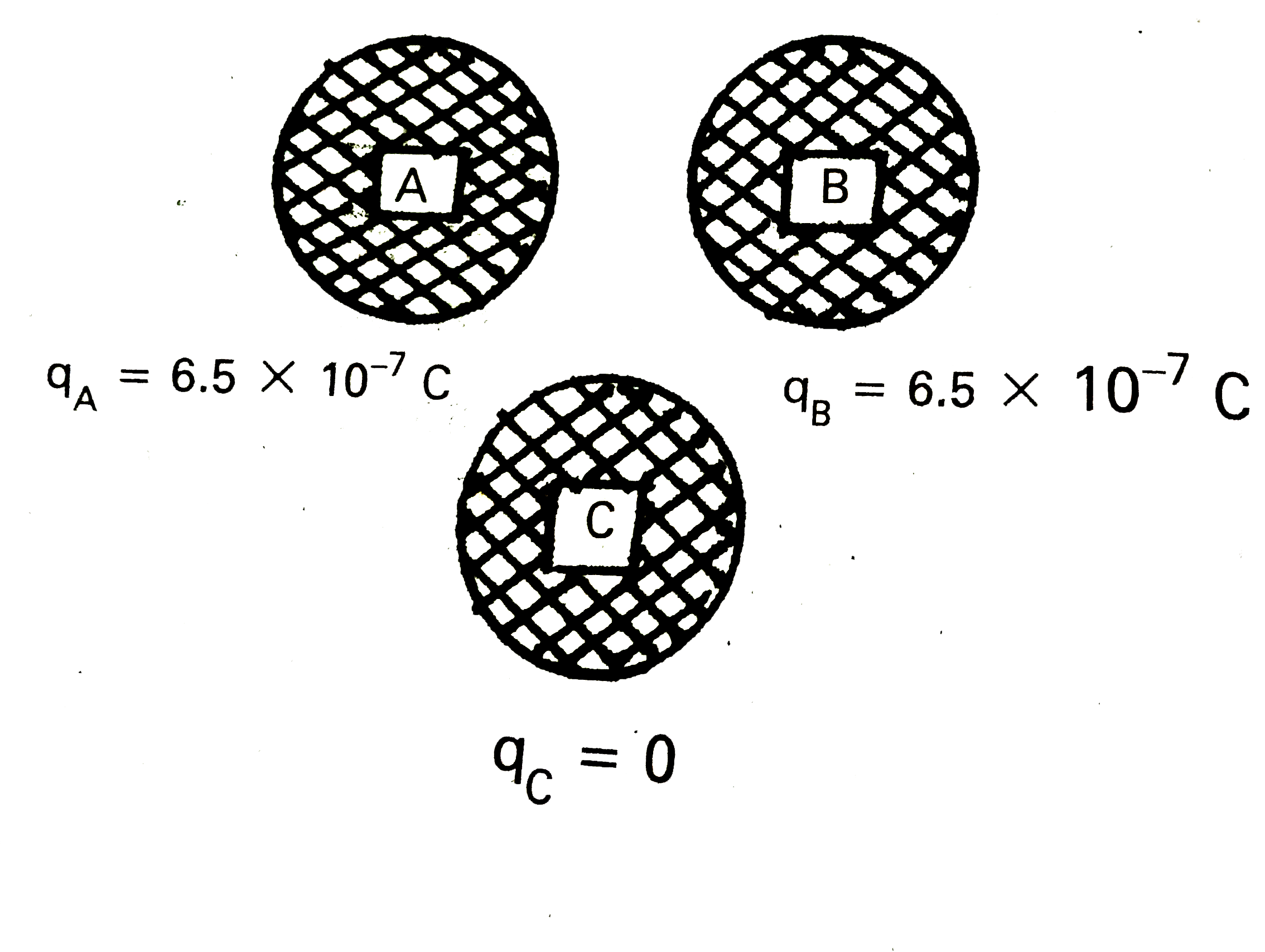
View SolutionFigure shows tracks of three charged particles in a uniform electrostatic field. Give the signs of the three charges. Which particle has the highest charge to mass ratio?

View SolutionConsider a uniform electric field `bar(E)=3 xx10^(3) NC^(-1)`. What is the flux of this field through a square of 10 cm on a side whose plane is parallel to the YZ plane?
View SolutionConsider a uniform electric field `E=3xx10^(3) hat(i) N//C`. A square of 10 cm on a side whose plane is parallel to the yz plane.
What is the flux through the same square if the normal to its plane makes a `60^(@)` angle with the x-axis?
View SolutionWhat is the net flux of the uniform electric field of Exercise - 15 through a cube of side 20 cm oriented so that its faces are parallel to the coordinate planes?
View SolutionCareful measurement of the electric field at the surface of a black box indicates that the net outward flux through the surface of the box is `8.0 xx10^(3) Nm^(2)`/C. What is the net charge inside the box?
View SolutionCareful measurement of the electric field at the surface of a black box indicates that the net outward flux through the surface of the box is `8.0 xx10^(3) Nm^(2)`/C. If the net outward flux through the surface of the box were zero, could you conclude that there were no charges inside the box? Why or Why not?
View SolutionA point charge `+10 muC` is a distance 5 cm directly above the centre of a square of side 10 cm, as shown in fig. What is the magnitude of the electric flux through the square?
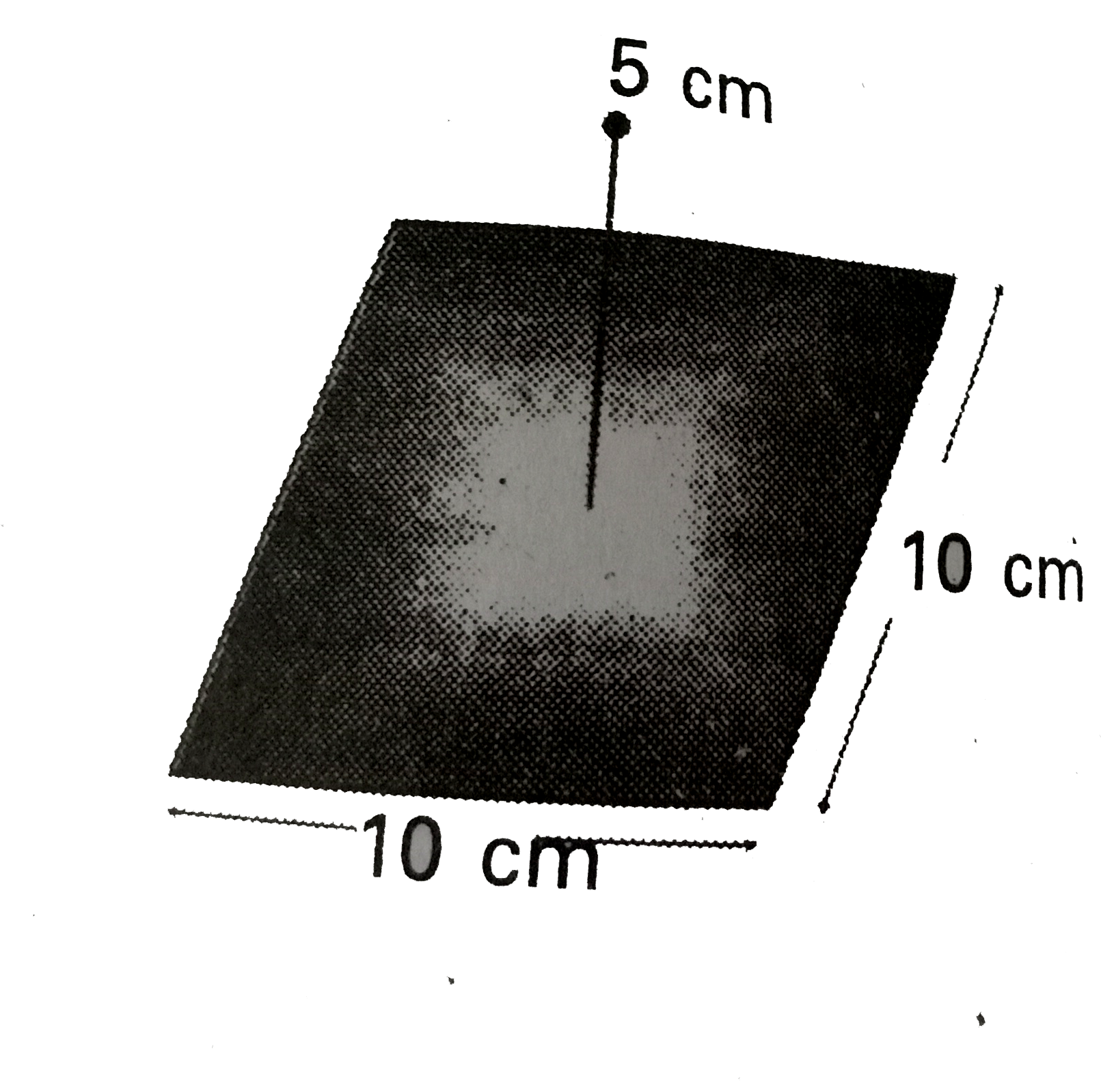
View SolutionA point charge of `2.0 muC` is at the centre of a cubic Gaussian surface 9.0 cm on edge. What is the net electric flux through the surface?
View SolutionA point charge causes an electric flux of `-1.0xx10^(3) Nm^(2)//C` to pass through a spherical Gaussian surface of 10.0 cm radius centred on the charge. If the radius of the Gaussian surface were doubled, how much flux would pass through the surface?
View SolutionA point charge causes an electric flux of `-1.0xx10^(3) Nm^(2)//C` to pass through a spherical Gaussian surface of 10.0 cm radius centred on the charge. What is the value of the point charge?
View SolutionA conducting sphere of radius 10 cm has an unknown charge. If the electric field 20 cm from the centre of the sphere is `1.5xx10^(3) N//C` and points radially inward, what is the net charge on the sphere?
View SolutionA uniformly charged conducting sphere of 2.4 m dimeter has a surface charge density of `80.0 mu C//m^(2)`. Find the charge on the sphere.
View SolutionA uniformly charged conducting sphere of 2.4 m dimeter has a surface charge density of `80.0 mu C//m^(2)`. What is the total electric flux leaving the surface of the sphere?
View SolutionAn infinite line charge produces a fiels of `9xx10^(4)` N/C at a distance of 2 cm. calculate the linear charge density.
View SolutionTwo large, thin metal plates are parallel and close to each other. On their inner faces, the plates have surface charge densities of opposite signs and of magnitude `17.0xx10^(-22) C//m^(2)`. What is E : in the outer region of the first plate,
View SolutionTwo large, thin metal plates are parallel and close to each other. On their inner faces, the plates have surface charge densities of opposite signs and of magnitude `17.0xx10^(-22) C//m^(2)`. What is E : in the outer region of the first plate,
View SolutionTwo large, thin metal plates are parallel and close to each other. On their inner faces, the plates have surface charge densities of opposite signs and of magnitude `17.0xx10^(-22) C//m^(2)`. What is E : between the plates?
View SolutionAn oil drop of 12 excess electrons is held stationary under a constant electric field of `2.55xx10^(4) NC^(-1)` in Millikan's oil drop experiment. The density of the oil is 1.26 g `cm^(-3)`. Estimate the radius of the drop, `(g=9.81 ms^(-2), e=1.60xx10^(-19) C)`.
View SolutionWhich among the curves shown in Fig. cannot possibly represent electrostatic field lines?
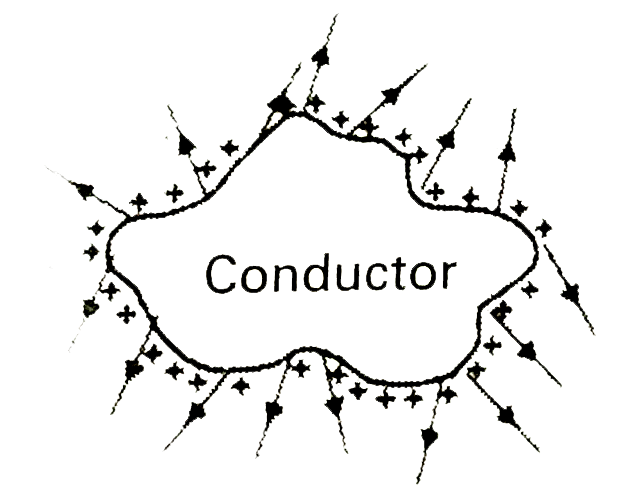
View SolutionWhich among the curves shown in Fig. cannot possibly represent electrostatic field lines?

View SolutionWhich among the curves shown in Fig. cannot possibly represent electrostatic field lines?
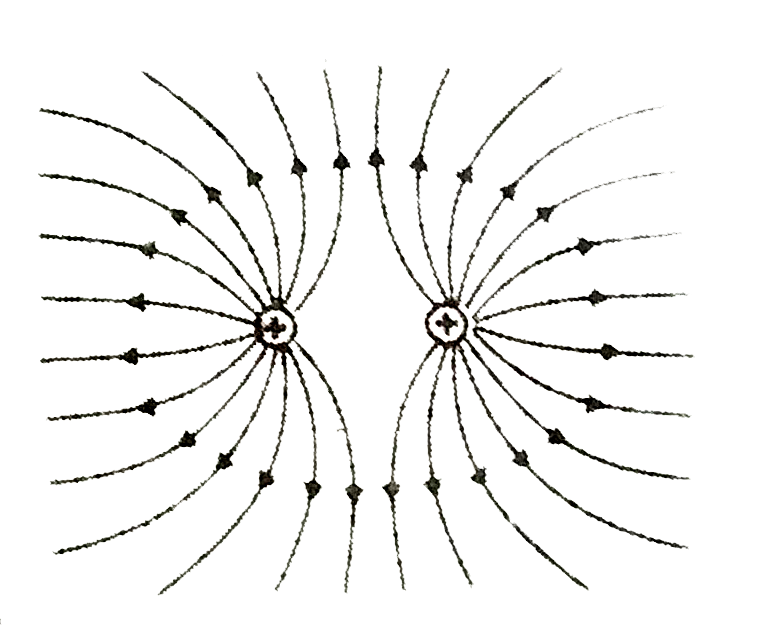
View SolutionWhich among the curves shown in Fig. cannot possibly represent electrostatic field lines?

View SolutionWhich among the curves shown in Fig. cannot possibly represent electrostatic field lines?
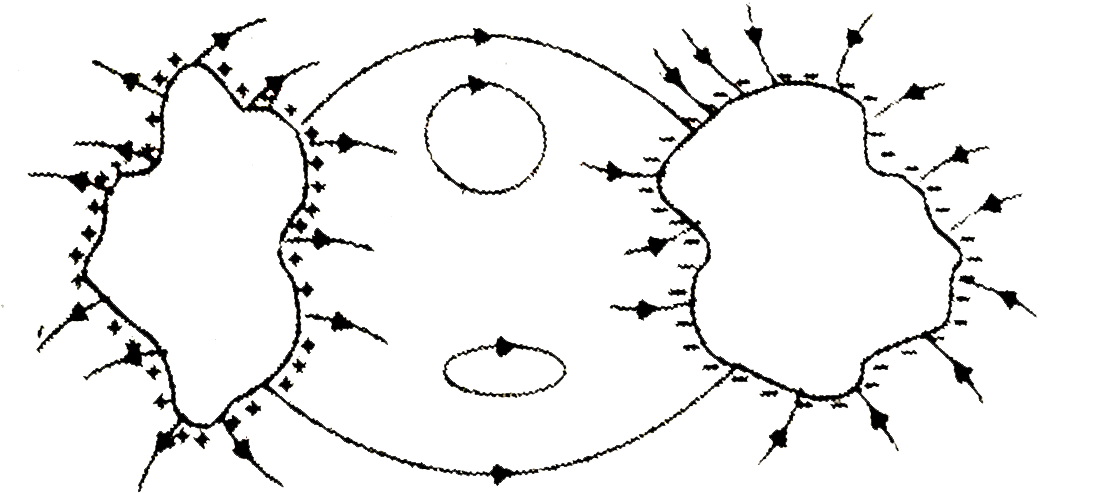
View SolutionIn a certain region of space, electric field is along the Z-direction throught. The magnitude of electric field is, however, not constant but increases uniformly along the positive Z-direction, at the rate of `10^(5) NC^(-1)` per metre. Whay are the force and torque experienced by a system having a total dipolemoment equal to `10^(7)` Cm in the negative Z-direction?
View SolutionA conductor A with a cavity as shown in Fig. is given a charge Q. Show that the entire charge must appear on the outer surface of the conductor.

View SolutionAnother conductor B with charge q is inserted into the cavity keeping B insulated from A. Show that the total charge on the outside surface of A is `Q + q`
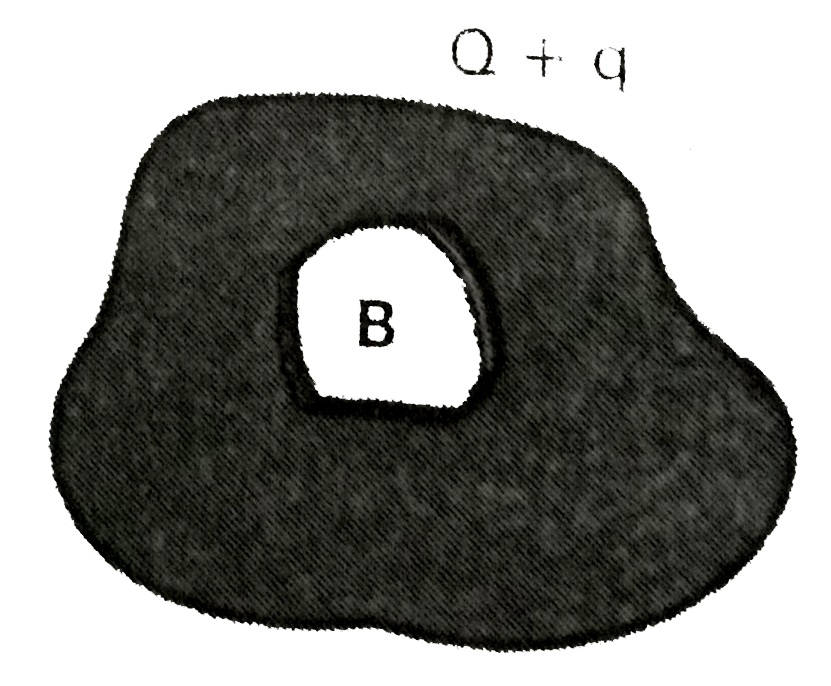
View SolutionA sensitive instrument is to be shielded from the strong electrostatic fields in its environment. Suggest a possible way.
View SolutionA hollow charged conductor has a tiny hole cut into its surface. Show that the electric field in the hole is `(sigma//epsi epsi_(0))hat(n)`, where `hat(n)` is the unit vector in the outward normal direction and `sigma` is the surface charge density near the hole.
View SolutionObtain the formula for the electric field due to a long thin wire of uniform linear charge density `lambda` without using Gauss's law.
View SolutionIt is now believed that protons and neutrons (which constitute nuclei of ordinary matter) are themselves built out of more elementary units called quarks. A proton and a neutron consist of three quarks each. Two types of quarks, the so called 'up' quark (denoted by u) of charge + (2/3)e and the 'down' quark (denoted by d) of charge (-1/3) e, together with electrons build up ordinary matter. (Quarks of other types have also been found which give rise to different unusual varieties of matter.) Suggest a possible quark composition of a proton and neutron.
View SolutionConsider an arbitrary electrostatic field configuration. A small test charge is placed at a null point (i.e., where E=0) of the configuration. Show that the equilibrium of the test charge is necessarily unstable.
View SolutionVerify this result for the simple configuration of two charges of the same magnitude and sign placed a certain distance apart.
View SolutionA particle of mass m and charge (-q) enters the region between the two charged plates initially moving along x-axis with speed `V_(x)` (as in the fig.). The length of plate is L and an uniform electric field E is maintained between the plates. Show that the vertical deflection of the particle at the far edge of the plate is `qEL^(2)//(2mV_(x)^(2))`.
Compare this motion with motion of a projectille in gravitational field discussed in section 4.10 of `1^(st)` Year Textbook of Physics.
View SolutionSuppose that the particle is an electron projected with velocity `V_(x)=2.0xx10^(6) ms^(-1)`. If E between the plates separated by 0.5 cm is `9.1xx10^(2)N//C`, where will the electron strike the upper plate? `(|e|=1.6xx10^(-19) C, m_(e)=9.1xx10^(-31) kg)`.
View Solution
ADDITIONAL EXERCISES questions and complete solutions for chapter ELECTRIC CHARGES AND FIELDS of VIKRAM PUBLICATION ( ANDHRA PUBLICATION) of Class 12